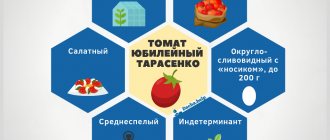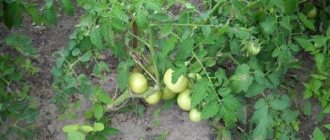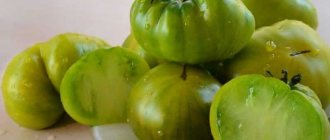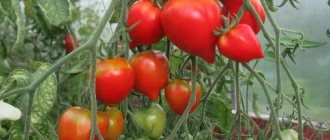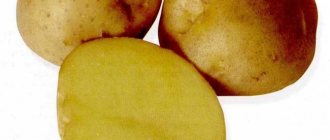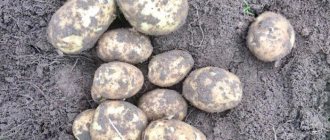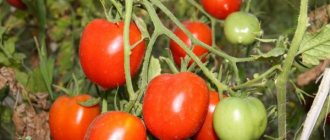Legendary varieties of tomatoes, bred by a school physics teacher, gained popularity in the last century and have not lost their relevance to this day. On the contrary, they are becoming increasingly widespread due to their reliability and simple agricultural technology.
The Jubilee Tarasenko tomato is suitable for those who want to get a rich harvest from a small plot, spending a minimum amount of time and effort. The taste of ripe vegetables will please you not only in fresh salads, but also in winter preparations.
Characteristics and description of the variety
Ukrainian physics teacher and amateur gardener F. M. Tarasenko developed more than 50 types of tomato crops. The Legend Tarasenko and Yubileiny tomatoes are especially popular. The Yubileiny Tarasenko tomato variety is much older than Legend; it has been known to gardeners for 30 years. It is based on several varieties and hybrids, one of which is the Mexican variety San Marzano.
Distinctive features
The type is indeterminate, height is 2-3 m, which is why the culture is called liana-like. The stem is powerful, the foliage is weak, the leaves are large, dark green. The inflorescences are simple, growing in the form of a cluster. The clusters are complex, each producing 20-25 fruits. The first brush is formed above the 9th leaf, subsequent ones every 2 leaves.
Mid-season species, 115-120 days pass from the moment of seedlings to full ripening. Fruiting is extended, ripe vegetables are harvested within 1.5 months.
The yield is high, up to 8 kg is harvested from 1 seedling when placing 2 plants per 1 square meter. m.
Resistance to the main diseases of the nightshade family is high. The culture is immune to late blight and brown spot.
Recommended for cultivation in open ground and in greenhouse conditions. The species is resistant to low temperatures.
Tall bushes require obligatory staking and regular pinching.
Fruit characteristics
Average weight 90-100 g, round, slightly elongated shape, red-orange color. The taste is rich, sweet and sour. The pulp is dense, fleshy, the peel is thin but durable and does not crack.
The purpose is universal; the fruits are used fresh for preparing a variety of dishes. Thanks to their durable skin, they do not crack during salting and preservation. It is used extremely rarely in processing for tomato products; due to the dense pulp, it is almost impossible to obtain juice from tomatoes.
Tomatoes can be stored for up to several months and can withstand long-term transportation.
The photo shows Yubileiny Tarasenko tomatoes.
Tomato variety Yubileiny Tarasenko, video
If you grew tomatoes of the Yubileiny Tarasenko variety, please write whether you liked them or not. What was the yield and taste of the fruits in your climatic conditions? How do you rate the disease resistance of this variety? Briefly describe the advantages and disadvantages of this tomato in your opinion. If possible, attach a photo of the entire bush or individual tomatoes you grew to your comment. Thank you!
Your reviews of the Yubileiny Tarasenko tomato and additions to the description will help many gardeners evaluate this variety more objectively and decide whether it is worth planting or not.
A huge number of tomato varieties with photos, descriptions and reviews from gardeners in our Tomato Catalog in alphabetical order. Enjoy watching.
How to grow seedlings
Sowing seeds for seedlings begins 2 months before planting in the ground. Gardeners can collect seed material from their own harvest, since it is a varietal crop, which means the genetic information is preserved for years.
Seed preparation
Self-harvested grains are disinfected and prepared for sowing. Disinfection takes place in a weak solution of potassium permanganate for 20-30 minutes. Then they are washed and dried.
To improve germination, the grains are soaked in a growth stimulator for 11 hours. As a stimulant, in addition to special preparations, melt or ordinary boiled water is used.
Reference! The most commonly used growth stimulants are Epin, Kornevin and Immunocytophyte.
Container and soil
The soil is prepared from garden soil and humus in equal quantities. A little sawdust or washed river sand is added as a leavening agent. The resulting mixture is poured with a hot solution of dark potassium permanganate or steamed in the oven at 60 °C for 10 minutes. The cooled soil is laid out in planting containers, filling them halfway. This makes it possible to add soil to the containers as the seedlings grow, thereby providing additional nutrition.
You can plant them in a common wooden box or in individual containers, at the bottom of which drainage holes are first made. When planting in separate containers, further care for tomatoes is reduced to a minimum.
Reference! Drainage holes at the bottom of the planting containers do not allow moisture to stagnate, which prevents the development of diseases such as blackleg.
Sowing
Seeds are sown to a depth of 2 cm with a distance of 3 cm from each other. Sprinkle soil on top, lightly compact and cover the containers with film to create a greenhouse effect. Planting containers are left in a bright and warm room at a temperature of 24-25 °C. Periodically, the film is removed for ventilation and, as the upper soil layer dries out, it is moistened with warm, settled water using a spray bottle.
Seedling care
When shoots appear, the film is removed and the containers are moved to the windowsill. Since seedlings tend to stretch, it is necessary to provide a sufficient amount of light for a long time. During the first few days, experienced gardeners illuminate the plantings around the clock with electric fluorescent lamps.
Water with moderately warm, settled water along the edge of the containers using a shallow watering can. After watering, the soil is loosened with a wooden stick or an ordinary fork.
Reference! Loosening is carried out superficially so as not to touch the young roots.
When 2 true leaves appear, the seedlings are picked and placed in separate containers. During picking, strong and healthy plants are left for further development. After picking, the growth and development of seedlings is more intense.
Reference! When growing seedlings in peat containers, picking is not required.
Hardening begins 2 weeks before planting in the ground. To do this, the seedlings are taken out into the open air for 1 hour during the daytime. Gradually the time interval is increased to 12 hours. Simultaneously with daytime hardening, the night temperature in the room is reduced to 13 °C.
"Hybrid Tarasenko 7"
Among the tall varieties there is one, bush and determinate, and this is the “Hybrid Tarasenko 7” tomato.
The plant is a bush type, but due to high yields it requires staking. But you can refuse stepsoning. Each tomato cluster bears 4-6 fruits weighing 100-120 g. The shape of the tomato is round with a slightly elongated apex.
The taste of tomato is also very high, like its fellows. Many argue that today’s market is overcrowded with “plastic” tomatoes and only Tarasenkovites are saving those vegetable growers who value the true taste of tomatoes.
There is also confusion with this hybrid. It is served to vegetable growers either with oval fruits or as flat-round fruits.
The color scheme also differs for each packer. However, the fact is that the fruit changes color like a chameleon. A single tomato plant can bear red, rose-red and pink fruits. But the tomatoes are very even in size, homogeneous with a high marketable yield.
Medium ripening tomato. If you grow it in a culture without seedlings, as some manufacturers recommend, then ripening is delayed and the clusters do not have time to fully produce their harvest.
Sustainability
Belonging to the Tarasenkov family, Hybrid 7 has the same high resistance to disease and weather abnormalities as the others.
There are no complaints about its pain and poor fruit set. But the fact that this hybrid bears fruit perfectly even in abnormal heat is repeatedly mentioned in the review.
The tomato also tolerates drought well. This variety is very fond of those vegetable growers who rarely visit the garden.
Advantages:
- productivity;
- resistance to abnormal temperatures;
- excellent taste;
- no need for pinching;
- keeping quality;
- disease resistance.
How to grow tomatoes
After 2 months, the seedlings are ready for transplanting. At this time, the bushes have 6-8 leaves and fully formed young roots.
Landing
Planting pattern: 70 cm – distance between seedlings, 90 cm left between rows. For 1 sq. m place no more than 2 plants.
The holes are prepared in advance with a depth of 30 cm, a little wood ash is placed on the bottom and filled with water. After planting, water again with warm, settled water and leave the seedlings to get used to the new place for 1 week.
Important! If the seedlings have stretched out, the bushes are placed in the holes reclining.
Planted in the evening or on a cloudy day when the sun is not shining at full strength. The holes are made in a checkerboard pattern, since this method of planting allows each seedling to receive a sufficient amount of sunlight and be well ventilated.
Further care for the Jubilee tomato
Regular watering is established as soon as the young bushes get used to the new conditions and get stronger. Water with settled water no more than 2 times a week, without flooding the seedlings. Tomato does not like excess moisture, but too little has a negative effect on the crop. The plant responds well to drip watering. To do this, place a plastic bottle without a bottom in the root system and fill it with water. Gradually moisture penetrates to the roots.
Mulching is used to retain moisture in the beds. Peat straw or weeds are used as mulch, which, when decomposed, provide the soil with additional beneficial substances.
After watering, the soil is loosened and hilled up to ensure a better flow of oxygen to the roots.
As plants develop, they need feeding. For the first time they are fed a week after transplantation with a complex of mineral fertilizers or organic matter. From organic matter, mullein infusion or bird droppings are used in a ratio of 1:15. Chlorine-containing fertilizers are not recommended, as is fresh manure.
The second feeding is applied at the time of flowering, feeding with phosphorus-potassium fertilizers. The third time is fed during the fruiting period with fertilizer containing mainly potassium substances. After 3 weeks, fertilizing is repeated.
Reference! Potassium fertilizers accelerate the ripening of fruits.
Features of cultivation and possible difficulties
Despite the powerful trunk, the plant cannot withstand the weight of the fruits, since there are too many ovaries. To avoid compromising the integrity of the bushes, they are tied to supports installed nearby. Not only the stem is tied up, but also the fruit-bearing branches as they develop. Another option for gartering is fixing it to a trellis. To do this, install metal supports on different sides of the bed and stretch wire between them. The bushes are fixed to the wire with soft fabric tapes.
The culture is most often formed into 1 stem. To do this, leave the strongest shoot and remove the rest. The rapid growth of bushes contributes to the frequent formation of lateral shoots. Therefore, stepchildren are removed regularly, once every 10 days. Without pinching, thickening of plantings is inevitable, which will lead to the spread of fungal infections.
Diseases and pests
The risk of fungal infection is especially high in greenhouse conditions due to constantly increased humidity and temperature. Therefore, closed structures are ventilated daily, thereby regulating the humidity level. It is also necessary to remember about prevention in the form of loosening, moderate watering and mulching of the beds. Before planting, tomato beds are watered with a solution of copper sulfate, which cleanses the soil of pathogenic spores.
When infected, plants are treated with Fitosporin or the drug HOM.
Reference! Fungal infections can destroy all plantings in 14 days.
In open ground, plants are often attacked by pests. To prevent them from multiplying quickly, seedlings are inspected every day for the presence of parasites. The inspection is carried out carefully, from all sides, since the larvae of the Colorado potato beetle are not easy to notice: they are located on the back side of the leaf. They are collected by hand. When there is a large concentration of insects, use the drug "Prestige".
To get rid of aphids, the stems are treated with a soap solution. It is done simply: 1 piece of laundry soap is dissolved in a bucket of water. If there is a large concentration of aphids, the plants are treated entirely.
Any preventive measures and spraying for treatment purposes are carried out in dry weather.
"Hybrid Tarasenko 3"
Medium ripening tomato. The height of the shoots easily reaches 150 cm. The plant is indeterminate. It is advisable to carry out the formation in 1-2 shoots. Tomato "Hybrid Tarasenko 3" requires constant tying up of shoots. Its clusters are huge and can bear from 8 to 15 fruits.
The variety is recommended for cultivation in greenhouses and open ground.
Fetus
A tomato with a distinct cuboid shape. Red, dense, with smooth skin and without a hint of ribbing.
Being very dense in appearance, the tomatoes are sugary and fleshy when cut. No one can say that the fruits are hard and at the same time they are quite juicy.
Although the weight of the tomato reaches 140-150 g, its shape allows it to fit into the neck of the jar. Having tried canned products from this variety, some vegetable growers recognize it as the best. Quality is determined by the fleshiness and juiciness of the pulp of pickled and canned tomatoes, and also by the fact that the fruit does not contain voids. By pulling it out of a jar or barrel, you can easily cut it into pieces, which is rarely possible to do with canned tomatoes.
This variety is also favored by those housewives who prepare salads for the winter. This variety holds its shape amazingly. The slices are smooth, identical, neat.
Tomato juices and sauces are thick, red and very aromatic.
The tomato does not crack, either in a jar or in a garden bed.
The resistance of Tarasenko varieties to diseases also applies to hybrid No. 3.
Advantages:
- excellent yield;
- excellent pickling qualities;
- high resistance to diseases.
Nuances when breeding in open and protected ground
Characteristics, description of the variety and photos of bushes with numerous ovaries allow us to note the high yield. Although Tarasenko himself claims that 8 kg from 1 seedling is not the limit. If you follow the rules of crop rotation and agrotechnical practices, it is possible to double the quantitative indicator.
According to the rules of crop rotation, tomatoes are not planted twice in the same place, or the top layer of soil is changed, supplying it with mineral fertilizers. Good predecessors to tomato crops are: carrots, cabbage, legumes and onions. After them, the soil is not depleted and is quite capable of saturating any plant from the nightshade family.
The root system of the variety is developed; the roots do not go down, but branch underground, which allows them to feed on minerals and moisture from the soil. Therefore, Jubilee is not afraid of drought, but excess moisture is destructive.
When the plants reach 1.7-1.9 m, pinch the top, leaving 2 leaves. Otherwise, the stem will grow up to 3 m, and the developing fruits will not have enough nutrients for full development.
"Hybrid Tarasenko 2"
The variety is the most popular from the Tarasenko series. Many generations of vegetable growers are familiar with this tomato. The plant is early, indeterminate, tall, some describe it as liana-like. The height in the greenhouse can easily exceed 2 m.
On issues of formation, the opinions of experts vary. If the soil is very nutritious, it is recommended to plant it in two or even three shoots. In this case, the variety will feed and pull out the entire huge harvest, but careful garters are required. If the soils are fresh and fertilizing is not carried out at all, then only in one shoot.
Reading the description of the yield of the tomato “Hybrid Tarasenko 2”, sometimes those who have not yet grown it doubt the veracity of the information, but after trying the variety in their beds, they are convinced that its complex tomato cluster can carry up to 30 tomatoes. Some vegetable growers provide information that the weight of one brush can be within 2 kilograms.
Harvesting and application
Judging by the reviews of gardeners, it is most convenient to collect Tarasenko tomatoes when they are slightly unripe. The fruits will ripen on their own in a few days, and ripening at room temperature will not affect the taste in any way. Thanks to extended fruiting, the harvest of ripe vegetables lasts up to 1.5 months.
Although the species belongs to the salad variety, the purpose of ripe vegetables is universal. They are great for fresh consumption in various dishes, marinades and pickles are made from them, and smaller tomatoes are used in whole-fruit canning. But you can’t make juice from tomatoes because of their dense pulp, but they are great for making various sauces.
The presence of a strong peel provides ripe vegetables with long-term storage and the ability to transport them over long distances without losing their presentation.
"Hybrid Tarasenko 6"
The mid-season variety is lower in height than its hybrid counterparts and reaches only 1.2-1.5 m. The plant is indeterminate and requires strict management in one shoot.
The tomato “Hybrid Tarasenko 6” is less popular than other participants in the series, but it’s completely in vain. Being prolific, and the weight of the fruit sometimes reaches 350 g, it has a flat-round shape.
The variety is highly respected by gourmets. Its dense skin perfectly retains the fleshy pulp, and its large fruit allows you to peel the tomato either with a vegetable knife or by pouring boiling water over it. When added to a salad, such a tomato is tender and pleasant, and its taste is simply unique.
Once you remove a tomato from the garden, you can enjoy its taste for a long time, since it has amazing shelf life.
Misgrading often happens with this hybrid. When selling seeds, sellers draw oval and “nosed” tomatoes on the bags, which also happens with the description.
Like all Tarasenkovites, the variety is very resistant to temperature fluctuations and diseases.
Advantages:
- excellent yield;
- large fruit;
- wonderful taste properties;
- good keeping quality;
- high transportability;
- disease resistance.
Advantages and disadvantages
The numerous advantages of the anniversary tomato are undeniable:
- adaptation to low temperatures;
- possibility of breeding in all regions;
- unpretentiousness;
- the ability to form ovaries under any conditions;
- high immunity to diseases;
- increased productivity;
- excellent taste of fruits;
- marketable condition;
- versatility in cooking;
- long storage;
- long transportation;
- the ability to independently collect seeds for planting.
Negative indicators include:
- regular stepsoning;
- need for garter;
- mandatory pinching.
Planting dates and care features
In order for Jubilee Tarasenko to fully reveal the potential of the variety, it needs to be provided with special care. If you don’t have the time or desire for this, you won’t be able to get 17 kg of tomatoes from a bush, although the harvest will still be very good.
Seedlings are grown in the same way as other tomatoes. They are moved to a permanent place at the age of about 60 days, when the soil warms up to the following temperature:
- 15° C – to plant in the garden;
- 10° C – for greenhouses.
Landing
It is better to prepare the holes in the fall. They are dug to a depth of 40 cm, a diameter of 50 cm, and the distance between centers is maintained at 1 m.
Make a planting mixture - the top, fertile layer of soil is mixed with additives:
- humus - 2 buckets;
- ash – 3-4 cups;
- mineral complex – 50 g.
By spring, the phosphorus contained in the fertilizer will be converted into a form that can be absorbed by tomatoes and will ensure the development of a powerful root.
Plant 2 bushes per hole to grow into 2 stems. It is recommended to water each tomato with a bucket of pink potassium permanganate solution.
Formation
The stepsons are removed when they reach a length of 3-4 cm. They try not to touch the leaves - there are already few of them, but there are a lot of fruits that grow throughout the season. Only those that lie on the ground are removed. Even in those affected by pests or diseases, it is recommended to prune individual segments or parts of them.
The tops can be pinched 45 days before the expected end of the gardening season. But by this time, the main shoots in the greenhouses will reach 2.5-3 m, each will have 5-6 tassels, which will still not fully ripen. Topping is carried out after the formation of 3 clusters on each trunk.
When growing tomatoes in a heated greenhouse, more fruit clusters are left.
Garter
Tomato Tarasenko The anniversary author of the variety recommends tying it to a trellis, forming a palmette. This way the bush will be well ventilated and illuminated. A significant distance between plants will provide sufficient feeding area for a powerful root system.
You can arrange a palmette for tomatoes like this:
- Drive stakes or pipes 3 m high every 3-4 m.
- Stretch 5-7 rows of wire.
- Shoots and bunches are tied up.
Massive brushes simply won’t hold on and will break the stem. It is imperative to secure them to a support.
Further care is the same as for other tomatoes. It includes:
- regular even watering;
- fertilizing, first with a predominance of nitrogen, then with phosphorus and potassium;
- preventative treatments;
- harvesting.
Farmer reviews
Varieties and hybrids from the physics teacher are incredibly popular among gardeners. The opinions of gardeners will convince anyone of the reliability of the crops.
Raisa, Vologda: “Last year I grew Tarasenko pink tomato, and this time I planted Yubileiny. The variety is not difficult to care for, although the bushes have reached great heights. I planted it often, watered it regularly, and as a result I got a huge amount of magnificent tomatoes with excellent taste. I’ve made a lot of preparations, now I’ll have tomatoes all winter.”
Irina, Stavropol Territory: “After seeing the photograph, distrust bordered on curiosity. I couldn’t believe that a seedling could bear so many fruits. I saw it with my own eyes when I planted the variety on my plot. The bushes stood healthy all season and produced a magnificent harvest. I’m very pleased with the result.”
Official information
The authorship of the Tarasenko hybrid series belongs to the amateur breeder F.M. Tarasenko. In the 80s of the 20th century, a physics teacher worked on developing his varieties in the village. Voronezh, Sumy region, Ukraine.
Over the course of 30 years, the breeder managed to give the world a whole series of varieties, although their name begins with the word hybrid. The second word in the title is the author's last name, and then only numbers. Those who once sowed and grew the Tarasenka variety always find a place in the garden for further cultivation.
Reviews from vegetable growers indicate that the seed fund does not undergo any changes for a long time and people have been collecting their seeds for years and growing excellent tomatoes from them.
Transplanting seedlings into the ground
When planting strong seedlings of Legend Tarasenko in the ground, you should know that the root system of these tomatoes is very powerful.
It penetrates deep into the soil substrate, becoming firmly established there. Therefore, transplanting young seedlings requires careful conditions and constant care of the plant. The plant is transplanted from a container into open ground in late May - early June. It is at this moment that the soil warms up to the required 15 C, and there is no longer any danger of return frosts. In addition, the Legend Tarasenko tomato bushes are already fully formed and have one ovary cluster.
Landing Features:
- The soil for growing in open areas should be prepared 1-1.5 months in advance or even in early autumn. Legend tomatoes are usually rooted by digging holes. Each depression in the soil should not be less than 50 cm wide and 40 cm deep.
- Humus and wood ash are added to the bottom of the pit. Next, mineral fertilizers – nitroammophoska – are added. All this is mixed with soil dug in advance. In this form, the recesses are left to wait until the planting work begins.
- Seedlings should be planted when they are about 2 months old. In order for the bushes to develop well and grow actively without interfering with each other, leave about 1 meter between neighboring bushes. And the rows are separated from each other by 1.5 meters.
- 2-3 seedlings are placed in each hole. This is necessary for the plants to hold on to each other. After planting, young shoots are irrigated with a solution of diluted manganese at a dosage of 3 grams. the drug per bucket of water (10 l).
Growing regions
Jubilee Tarasenko is suitable for growing in a variety of conditions, even in unprotected soil. Moreover, such conditions have almost no effect on productivity. In colder regions, fewer ovaries are formed on the bush, usually no more than 3-4. If you grow tomatoes in a greenhouse in the southern regions, at least 4-5 bunches develop on one plant.
Due to its high frost resistance, even in Siberian conditions, this variety demonstrates excellent fruiting.
Pest and disease control
Tomatoes of the Yubileiny Tarasenko variety are genetically resistant not only to short-term frosts and drought, but also to many diseases and pests. However, sometimes the plant is susceptible to fungal infections, whiteflies and aphids.
Standard protection measures:
- preventive treatment during the first week after transplantation;
- further processing as necessary.
The bushes are sprayed with fungicides (for example, Fitosporin, Strobi) and insecticides (Biotlin, Inta-Vir and others). At the first stages, folk remedies also help to cope with tomato diseases and pests (for example, you can put a trap for whiteflies in a greenhouse, and to kill aphids, treat the shoots with an infusion of garlic in water).
Important! From the last treatment of tomatoes of the Yubileiny Tarasenko variety with fungicides and insecticides, at least a week must pass before harvesting.
Description of fruits
These tomatoes are universally used - they are eaten fresh, canned whole and in salads, salted, dried, dried, used for juice and other tomato products.
- The shape is round, with a beautiful nose.
- The color is rich red, with an orange tint.
- The pulp is dense, juicy, fleshy, seed chambers, few seeds. The taste of the fruit is very pleasant, sweet, with a light fruity note.
- The skin is thin but dense and does not crack during canning.
- Excellent transportability, shelf life – a month or more.
